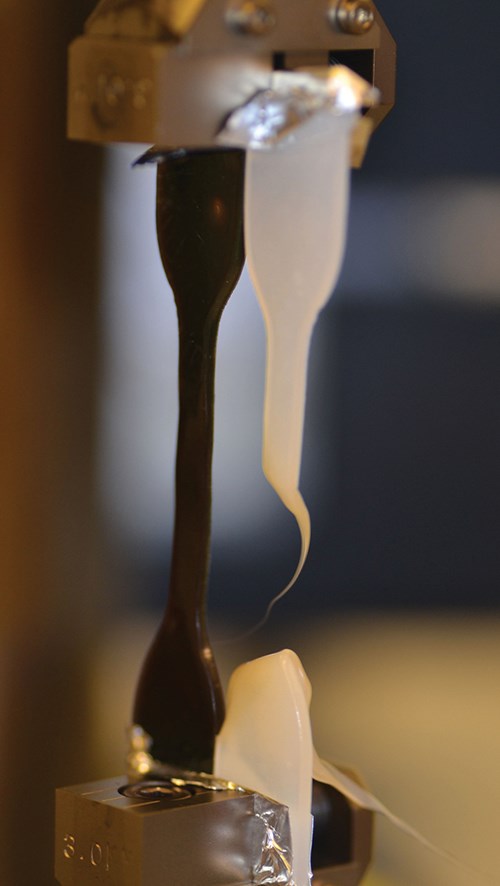Additives: Multi-Purpose Modifiers Pump Up Properties of Virgin & Recycled Plastics
A new slate of compatibilizers, chain extenders, and process aids improve properties and processability of resin alloys and mixed post-consumer recycle.
Four relatively new polymer modifiers have multiple functions in virgin and/or recycled resins. One is an unusual catalyst for compatibilizing multi-polymer blends and post-consumer recycle (PCR) mixtures and has promise to allow use of high levels of PCR in consumer goods. Second is a family of 1:1 alternating copolymers of ethylene and maleic anhydride (EMAh) modifiers that show high efficiency as chain extenders for engineering resins such as nylon and PBT, but are also promising in upgrading recycled nylon 6 and 66 and compatibilizing recycled PET in nylon 66.
Third is a new type of heat-activated additive that acts as a chain extender and branching agent for TPU, nylons, and polyesters, improving the processability and stability of extruded products. It also has promise for upgrading recycled materials. Fourth, are PHA bio-copolymers that act as compatibilizers, process aids, and secondary plasticizers in flexible and rigid PVC.
COMPATIBILIZING ALLOYS & PCR
A novel, year-old catalyst available in both powder and masterbatch form acts as compatibilizer for dissimilar polymers, including polyolefins, PET, PVC, and bioplastics like PLA. It is gaining increasing attention for use in PCR mixtures such as PP/PET/PE. It also has been shown to increase extrusion output and to lower cycle times in injection molding.
Developed by Kenrich Petrochemicals, Bayonne, N.J., Ken-React CAPOW KPR 12/HV powder and Ken-React CAPS KPR 12/LV pellets have been shown to regenerate PCR to virgin-like properties. The product is the result of combining the company’s single-site neoalkoxy LICA 12 titanate catalyst with a mixed-metal catalyst to “give more bang for the buck,” says Salvatore Monte, company president.
The basic composition of the KPR (Kenrich Polymer Recycle) blend is a masterbatch of 20%-active LICA 12 titanate catalyst, 19% alumino silicate; 11% SiO2 (silicon dioxide), and 50% LLDPE. Explains Monte, “The difference between KPR and LICA alone in recycle is that we have found an inorganic particulate that has mixed-metal catalysis effects, much like a Ziegler-Natta catalyst. We have replaced the inert inorganic silica as the carrier for the conventional 65% CAPOW powder and 20%-active CAPS pellet with this Z-N catalyst and now have a more powerful 80% active power and a 40%-active pellet.”
In her July Recycling Know-How article in this magazine, Compatibilizers Create New Recycle Feedstream Value, Kim Holmes, dir. of recycling and diversion at the Society of the Plastics Industry, discussed the merits and limitations of the three categories of compatibilizers—bipolar copolymers, maleated copolymers, and in-situ macromolecular catalysts, like KPR. She noted, “Copolymerization of two or more dissimilar polymers in the melt via in-situ catalysis using thermally stable organometallics holds the possibility of allowing the use of high levels of PCR in consumer goods.”
The key disadvantage of this class of additives is that their use in the recycling industry is not well known, according to Holmes: “Recyclers will have to become more familiar with reactive compounding techniques to optimize the catalysis effects and will need the capability to monitor and adjust melt-process conditions to optimize the work energy (defined as the area under the plot of polymer melt torque vs. screw residence time).”
Monte notes that the masterbatch can be used like a color concentrate, but must be melt compounded at 10% lower temperatures than normal to create sufficient shear because the catalyst reduces viscosity. The lower temperature is key in order to impart the optimal work energy at the interface of the dissimilar macromolecules to optimize the complete reaction of the 1.5-nm catalyst particles.
Kenrich has a patent that demonstrates how its titanates and zirconates improve flow and mechanical properties. In addition, the company’s literature demonstrates how its titanates can copolymerize resins such as PP and HDPE. Monte says the addition of 0.3% CAPOW KPR will produce a compatibilized 50/50 blend of HDPE/PP with excellent final part properties.
In one commercial success, a molder was trying to work off PP regrind into HDPE injection molded flower pots, but the products suffered delamination once the PP exceeded a 5% level. Using the additive catalyst, they were able to achieve a 50/50 blend without delamination and formed a copolymer in situ that was stronger than the virgin HDPE.
In yet another real-world application, a customer was able to load 50% tire rubber regrind into PP for automotive truck beds and meet specifications. Also, a major processor (which requested anonymity) reports that the Kenrich catalyst has proven very versatile in compatibilizing a number of resin systems using regrind.
Says Monte, “We are doing a large test in Toronto with a ton each of two PCR streams, and another in France. We are also doing tests with a university for a technical paper to be presented soon. We are also considering going into a partnership with a large polymer company that has the global footprint in compatibilizers and resources necessary to support the KPR brand at the marketing, regulatory, sales, and technical support level.”
UPGRADING RECYCLED NYLON
Vertellus Specialties Inc., Indianapolis, has been expanding its family of ZeMac copolymers—1:1 alternating copolymers of ethylene and maleic anhydride (EMAh), including ZeMac E60P powder and Extent masterbatches. The company has found these additives to be very efficient chain extenders for nylon, PBT, and other engineering resins.
Recent advances show a broad range of applications and benefits of ZeMac EMAh in nylon compounds, notes Ashok Adur, global commercial development director. In virgin resin, applications include commercial use of ZeMac to increase the relative viscosity (RV) of nylon for use in profile extrusion and blow molding. The increased melt strength afforded by the chain extender significantly reduces the cost—by about 40¢/lb—compared with high-RV nylon produced via solid-state polymerization. ZeMac has also been used to recover properties like tensile strength, flexural modulus, and HDT for higher-temperature usage of impact-modified nylon compounds while retaining their high impact strength.
Moreover, Adur says ZeMac is making headway in upgrading the performance of post-consumer and post-industrial recycled nylon and as a compatibilizer in recycle applications:
• It serves to upgrade recycled nylon 6 and 66 as long as the recycled nylon has at least 94% nylon content and is consistent in quality and composition. End-use applications are targeted to automotive underhood replacement markets such as air dams and flexible pressure hose, as well as electronics and small appliances.
• ZeMac can be used to reduce costs and maintain properties and performance by mixing in recycled resin—even if it’s not consistent in quality and composition, at 20-25%.
• It can compatibilize recycled PET in nylon 66 to cut costs by over 25¢/lb for many automotive parts, including underhood, chassis, and structural components, without losing performance. This approach can be a cost/performance alternative to either thermoset resins or virgin nylon 66.
On the matter of upgrading PCR nylon with chain extenders, Adur notes that fiber-grade nylons tend to have lower molecular weight and less robust properties than injection molding grades. PCR nylon is subjected to additional heat during reprocessing, reducing its molecular weight even further.
But a more significant issue with PCR nylon is that it is often contaminated with impurities such as polyester textile scrap; calcium carbonate, PP, and PUR from carpet waste; and various fillers and paints from automotive and appliance scrap. These make purity and consistency the two major challenges for PCR nylon. To meet the demand from injection molding, the properties of PCR nylon must be improved before it can be used to replace prime material to cut costs and increase sustainability.
Until recently, the industry has lacked effective methods for upgrading reclaimed and recycled nylon, according to Adur. When molten, most nylons exhibit Newtonian behavior, which means that at a fixed temperature, their viscosity is essentially flat as a function of shear rate. This limits applications for recycled nylon to those that do not require high melt strength. Adur says the most promising approach has been chain extension—the process of relinking broken polymer chains during compounding to increase molecular weight and mechanical properties.
However, some chain extenders resulted in a linear chain that was too high in molecular weight and created very high shear, making it difficult to injection mold the material. Unlike those early chain extenders, the novel EMAh copolymer converts the linear nylon molecule to a branched structure that results in non-Newtonian melt behavior—also referred to as shear thinning—which mitigates high torque and difficulty in injection molding, Adur says. “The
unique chemistry of this EMAh copolymer drives a rapid increase in
viscosity, and the resultant polymer exhibits high melt strength that
opens up new applications for upgraded nylon that were not possible
event with prime-quality nylon,” he says.
Vertellus recently evaluated the effectiveness of ZeMac copolymer in recycled nylon 66, using prime-quality nylon 6 and nylon 66 for comparison. Each was compounded with a 1:1 EMAh alternating copolymer grade and a stabilizer package. Here are some results:
• Prime nylon 6, 66: In both cases, mechanical properties were improved, along with an increase in HDT, while the MFR decreased.
• Recycled nylon 6: The recycled nylon used was primarily nylon 6 from industrial sources. Due to the presence of some nylon 66, the MFR was lower than would typically be expected from a recycled stream with just nylon 6. During compounding, the material generated less torque than the prime nylon 6 due to expected degradation caused by its additional heat history. MFR decreased due to the addition of EMAh, which produced chain extension and resulting branching. This branching led to shear thinning, which enabled excellent injection molding performance, confirmed by spiral flow data as well as by customer experience on large and small injection presses.
After reactive compounding with the EMAh alternating copolymer at very low loadings (0.1, 0.3, 0.5%), increases in the recycled nylon’s mechanical and thermal properties—tensile strength and elongation, flexural modulus and strength, Izod and Charpy impact strength, and HDT—demonstrate that this is a way to upgrade recycled nylon to match or even exceed the performance of prime nylon.
CHAIN-EXTENDING NYLON, POLYESTER, TPU
Nexam Chemical AB of Sweden offers globally a new type of heat-activated additives for enhancing processability and end-use performance of a broad range of plastics. The Nexamite technology consists of bi- or multi-functional substances that can be used for controlled chain extension, branching, or crosslinking of plastics. Nexamite additives can be processed using conventional equipment; their activation temperatures can range from 393 F to above 572 F.
Explains Dane Momcilovic, Nexam’s chief technology officer, “Our core competence is in development of products for controlled polymer modification. One important application area is the modification of melt strength and polymer viscosity. so far, we have devoted significant effort to polymers used for extrusion applications. Our modification technology also offers opportunities for upgrading recycled materials whose polymer chains very often are somewhat degraded and less stable from a processing perspective, as compared with their virgin counterparts.”
Among the most recent additions to Nexam’s line is Nexamite A56 PETA, a multifunctional additive based on a new molecule in the benzofuran family. It acts as chain extender and branching agent that increases the melt strength and viscosity and thus improves the processability of extruded products. Chain-extended and/or branched materials also typically exhibit improved mechanical properties.
To date, A56 formulations have been shown to offer such improvements in TPU, PET, PBT, and nylons 6, 11, 12, 610, and 612, according to Momcilovic. The improved properties can result in material savings or up to 30% via replacement of virgin with recycled material.
Nexamite A56 can be introduced into the polymer as a powder or masterbatch during conventional compounding. Once functionalized—through reaction with the polymer —chain-extending, branching, or crosslinking reactions take place. It is possible to control these reactions—favoring one or two—by varying the amount of the additive, process temperature, and the reaction time, explains Momcilovic. In long-chained nylons such as types 12, 610, 612, and 1010, the addition of A56 results in nearly threefold improvement in tensile elongation, and 25% improvements in tensile strength and 10% in tensile modulus.
PHA PLAYS MULTIPLE ROLES IN PVC
Metabolix, Cambridge, Mass., has changed the focus of the development program for its PHA biopolymer and now offers several PHA-based modifiers for processing and performance enhancement of other polymers, including PLA and PVC.
Two PHA copolymers are said to have unique miscibility in PVC: I6002 amorphous grade for flexible PVC and I6003 semicrystalline grade for rigid PVC. Max Senechal, Metabolix’s v.p. of strategy and commercial development, notes that there are at least five end-use applications in the works, with two expected to be commercial within the near term.
The first is flooring, whereby I6002 PHA copolymer serves as both a compatibilizer and an internal lubricant/processing aid, improving tensile toughness, tensile strength, torque reduction, and UV resistance. At use levels of 3-5%, it has been shown to facilitate use of increased levels of post-industrial and post-consumer recycle, as well as mineral filler, a big plus in this application, according to Senechal. The impact of such PHA copolymer on recycled PVC compounds includes improved fusion and gloss.
The second developmental application is extruded railing of PVC/wood polymer composites, where I6003 acts as both a compatibilizer and processing aid, promoting better dispersion of wood flour and mineral fillers. It allows for incorporation of up to 52% total filler in PVC building materials and profiles to improve stiffness and load-bearing capacity. This is accomplished at relatively low extruder torque levels, while high filler levels usually involve higher torque and wear.
Other applications being explored include roofing membranes, where I6002 acts as a high-molecular-weight secondary plasticizer and processing aid. It shows good permanence (low plasticizer migration) and oil and grease resistance. Wire and cable jacketing and tubing and films are other potential applications.
Related Content
Advanced Recycling: Beyond Pyrolysis
Consumer-product brand owners increasingly see advanced chemical recycling as a necessary complement to mechanical recycling if they are to meet ambitious goals for a circular economy in the next decade. Dozens of technology providers are developing new technologies to overcome the limitations of existing pyrolysis methods and to commercialize various alternative approaches to chemical recycling of plastics.
Read MoreFoam-Core Multilayer Blow Molding: How It’s Done
Learn here how to take advantage of new lightweighting and recycle utilization opportunities in consumer packaging, thanks to a collaboration of leaders in microcellular foaming and multilayer head design.
Read MoreAvoid Four Common Traps In Granulation
Today, more than ever, granulation is an important step in the total production process. Our expert explains a few of the many common traps to avoid when thinking about granulators
Read MoreA Recycling Plant, Renewed
Reinvention is essential at Capital Polymers, a toll recycler that has completely transformed its operation in a short period of time.
Read MoreRead Next
People 4.0 – How to Get Buy-In from Your Staff for Industry 4.0 Systems
Implementing a production monitoring system as the foundation of a ‘smart factory’ is about integrating people with new technology as much as it is about integrating machines and computers. Here are tips from a company that has gone through the process.
Read MoreTroubleshooting Screw and Barrel Wear in Extrusion
Extruder screws and barrels will wear over time. If you are seeing a reduction in specific rate and higher discharge temperatures, wear is the likely culprit.
Read More
































